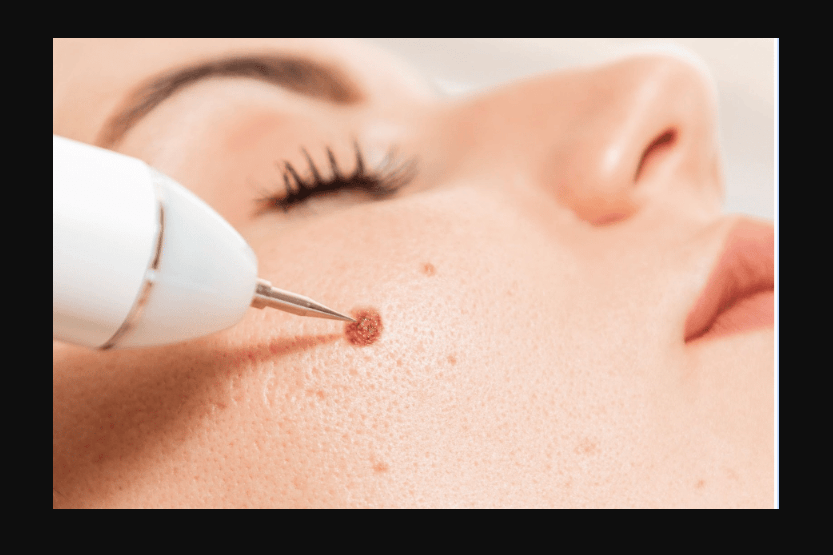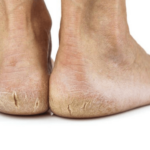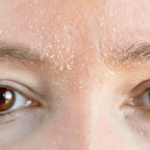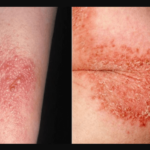Moles are common skin growths that can appear anywhere on the body. While most moles are harmless, some may be cancerous or may cause discomfort.
If you are looking for ways to get rid of a mole, there are several techniques that can be used for mole removal, including excision (cutting), and shave removal.
This article will introduce you to some of the effective ways of getting rid of moles on the skin.
Understanding Moles

Moles are common skin growths that can appear anywhere on the body. They are usually brown or black in color and can be flat or raised. While most moles are benign and noncancerous, some may develop into melanoma, a type of skin cancer.
Moles are formed when pigment cells called melanocytes grow in clusters. They can appear at any age, but most people develop them during childhood or adolescence. The number of moles a person has can vary greatly, with some people having just a few and others having hundreds.
Moles can be classified into different types based on their appearance. Common moles are small, round, and have a smooth surface. Atypical moles, also known as dysplastic nevi, are larger than common moles and have an irregular shape and color. They may also have an uneven surface and may be more likely to develop into melanoma.
While most moles are harmless, it is important to keep an eye on them and monitor any changes. If a mole changes in size, shape, or color, or if it begins to bleed or itch, it may be a sign of melanoma and should be checked by a dermatologist.
In general, it is recommended that people perform regular self-exams of their skin to check for any changes or new moles. This can be done using a body mole map, which is a diagram of the body that can be used to track the location and appearance of moles over time.
If a mole needs to be removed, there are several techniques that can be used, including excision and shave removal. After mole removal, it is important to take care of the area to prevent infection and scarring.
Identifying Harmless Vs Cancerous Moles
Moles are common skin growths that can appear anywhere on the body. Most moles are harmless and don’t require treatment, but some can develop into skin cancer. It’s important to know how to identify harmless moles from cancerous ones to ensure early detection and treatment.
Harmless Moles
Harmless moles are usually symmetrical, have smooth borders, and are a single color. They can be flat or raised, and most people have between 10 and 40 moles on their body. Harmless moles are typically less than 6 millimeters (about the size of a pencil eraser) in diameter.
Cancerous Moles
Cancerous moles, also known as melanoma, can be deadly if not detected and treated early. The ABCDE rule is a helpful tool for identifying potential signs of melanoma:
- A — Asymmetry: The two halves of a mole do not match.
- B — Border irregularity: The edges of the mole are ragged, notched, or blurred.
- C — Color: The mole has different colors or shades of brown, black, or tan.
- D — Diameter: The mole is larger than 6 millimeters (about the size of a pencil eraser).
- E — Evolving: The mole is changing in size, shape, or color.
If a mole displays any of the ABCDE signs, it’s important to see a doctor as soon as possible. Other signs of cancerous moles include:
- A mole that is different from other moles on the body
- A mole that is itchy, painful, or bleeds
- A mole that has a scaly or crusty surface
- A mole that is growing rapidly
Family History
People with a family history of skin cancer are at a higher risk of developing cancerous moles. It’s important for these individuals to have regular skin exams by a dermatologist to monitor for any changes or growths.
Mole Removal Procedures

Moles are common skin growths that can appear anywhere on the body. While most moles are harmless, some may become cancerous, and their removal may be necessary. There are several mole removal procedures available, and the choice of the procedure depends on the size, location, and type of mole.
Excision
Excision is a mole removal procedure that involves cutting out the mole and a small area of the surrounding skin with a surgical blade. The wound is then closed with stitches, which are removed after a week or two. Excision is usually recommended for larger moles or those that may be cancerous.
Cryosurgery
Cryosurgery is a mole removal procedure that involves freezing the mole with liquid nitrogen. The mole is frozen, and the surrounding skin is allowed to thaw. This process is repeated several times until the mole is completely frozen. The mole will then blister and scab over, and it will eventually fall off. Cryosurgery is usually recommended for smaller moles.
Laser Treatment
Laser treatment is a mole removal procedure that involves using a laser to destroy the mole cells. The laser beam is directed at the mole, and the heat from the laser destroys the cells. Laser treatment is usually recommended for smaller moles.
Surgical Excision
Surgical excision is a mole removal procedure that involves cutting out the mole and a small area of the surrounding skin with a surgical blade. The wound is then closed with stitches, which are removed after a week or two. Surgical excision is usually recommended for larger moles or those that may be cancerous.
Mole removal procedures are usually performed in a dermatologist’s office and are generally safe and effective. It is important to follow the dermatologist’s instructions for aftercare to ensure proper healing and to minimize scarring.
Home Remedies for Mole Removal
Moles are common skin growths that can appear anywhere on the body. While they are generally harmless, some people may find them unsightly or uncomfortable. Here are some home remedies that people have used to remove moles:
Garlic
Garlic is a natural remedy that some people believe can remove moles. To use garlic, crush a clove and apply it to the mole. Cover it with a bandage and leave it on overnight. Repeat this process for several nights until the mole disappears. Garlic contains enzymes that may dissolve the mole, but there is no scientific evidence to support this claim.
Iodine
Iodine is a common household antiseptic that some people use to remove moles. To use iodine, apply a small amount to the mole and cover it with a bandage. Leave it on overnight and repeat the process for several nights until the mole disappears. Iodine may cause the mole to dry out and fall off, but it can also cause skin irritation and should be used with caution.
Baking Soda and Castor Oil
A mixture of baking soda and castor oil is another home remedy that some people use to remove moles. To use this remedy, mix baking soda and castor oil to form a paste. Apply the paste to the mole and cover it with a bandage. Leave it on overnight and repeat the process for several nights until the mole disappears. This remedy may help to dry out the mole, but it can also cause skin irritation.
Tea Tree Oil
Tea tree oil is an essential oil that has antiseptic properties and is sometimes used to remove moles. To use tea tree oil, apply a small amount to the mole and cover it with a bandage. Leave it on overnight and repeat the process for several nights until the mole disappears. Tea tree oil may help to dry out the mole, but it can also cause skin irritation and should be used with caution.
Hydrogen Peroxide
Hydrogen peroxide is a common household antiseptic that some people use to remove moles. To use hydrogen peroxide, apply a small amount to the mole and cover it with a bandage. Leave it on overnight and repeat the process for several nights until the mole disappears. Hydrogen peroxide may help to dry out the mole, but it can also cause skin irritation and should be used with caution.
Aloe Vera
Aloe vera is a natural remedy that some people use to remove moles. To use aloe vera, apply a small amount of the gel to the mole and cover it with a bandage. Leave it on overnight and repeat the process for several nights until the mole disappears. Aloe vera may help to soothe the skin and reduce inflammation, but there is no scientific evidence to support its use for mole removal.
Apple Cider Vinegar
Apple cider vinegar is a popular home remedy that some people use to remove moles. To use apple cider vinegar, soak a cotton ball in the vinegar and apply it to the mole.
Cover it with a bandage and leave it on overnight. Repeat the process for several nights until the mole disappears. Apple cider vinegar may help to dry out the mole, but it can also cause skin irritation and should be used with caution.
Banana Peel
Banana peel is a natural remedy that some people use to remove moles. To use banana peel, cut a small piece of peel and place it over the mole. Cover it with a bandage and leave it on overnight. Repeat the process for several nights until the mole disappears. Banana peel may help to soothe the skin and reduce inflammation, but there is no scientific evidence to support its use for mole removal.
Frankincense Oil
Frankincense oil is an essential oil that some people use to remove moles. To use frankincense oil, apply a small amount to the mole and cover it with a bandage. Leave it on overnight and repeat the process for several nights until the mole disappears. Frankincense oil may help to dry out the mole, but it can also cause skin irritation and should be used with caution.
It is important to note that at-home mole removal remedies may not be effective and can cause skin irritation or scarring. If you are concerned about a mole, it is best to consult a dermatologist for professional removal.
Mole Removal Creams

Mole removal creams are a popular option for those looking to get rid of moles on their skin. These creams work by breaking down the mole cells, causing them to die and fall off. They are typically easy to use and can be applied at home.
When choosing a mole removal cream, it is important to look for one that is potent and effective. Some creams may take longer to work than others, so it is important to be patient and consistent with application. It is also important to follow the instructions carefully to avoid any potential side effects.
One popular mole removal cream is HaloDerm Wart and Mole Vanish. This cream is known for its potency and effectiveness in removing moles. It is easy to use and can be applied at home. However, it is important to note that this cream should not be used on sensitive areas of the skin.
Another option is Dr. King’s Mole Remover. This cream is made with natural ingredients and is gentle on the skin. It is effective in removing moles, but may take longer to work than other creams.
When using a mole removal cream, it is important to keep the area clean and dry. It is also important to avoid picking at the mole or scratching the area. This can cause irritation and potentially lead to infection.
Post-Removal Care and Recovery
After the mole removal procedure, it is important to take proper care of the affected area to ensure a smooth and speedy recovery. Here are some things to keep in mind:
Recovery
The recovery time for mole removal varies depending on the size and location of the mole, as well as the method used for removal. In general, it can take anywhere from a few days to a couple of weeks for the wound to heal completely. During this time, it is important to avoid activities that could irritate or reopen the wound, such as swimming or heavy lifting.
Infection
One of the biggest risks after mole removal is infection. To avoid infection, the patient should keep the wound clean and dry at all times. If the wound becomes red, swollen, or starts to ooze pus, it is important to seek medical attention immediately.
Scab
After mole removal, a scab will form over the wound. It is important not to pick at or scratch the scab, as this can slow down the healing process and increase the risk of infection. The scab will eventually fall off on its own, revealing the healed skin underneath.
Swelling
Some swelling and bruising around the wound is normal after mole removal. Applying a cold compress to the affected area can help reduce swelling and discomfort. If the swelling persists or gets worse, it is important to contact a healthcare provider.
Petroleum Jelly
Applying petroleum jelly to the wound can help keep it moisturized and prevent scarring. However, it is important not to apply too much petroleum jelly, as this can clog the pores and increase the risk of infection. A thin layer of petroleum jelly should be applied to the wound twice a day.
Preventing Moles
While it’s not always possible to prevent the development of moles, there are steps that can be taken to reduce the risk of developing new ones. Here are a few tips to help prevent the formation of new moles:
Protect Your Skin from the Sun
Exposure to UV radiation from the sun is a major risk factor for the development of moles. To reduce your risk of developing new moles, it’s important to protect your skin from the sun’s harmful rays. This can be done by:
- Wearing protective clothing such as long-sleeved shirts, pants, and hats
- Using a broad-spectrum sunscreen with an SPF of at least 30
- Avoiding direct sunlight during peak hours (10 a.m. to 4 p.m.)
Perform Regular Self-Exams
Performing regular self-exams of your skin can help you catch any new moles or changes in existing moles early. This can be particularly important for individuals who have a higher risk of developing skin cancer. To perform a self-exam:
- Use a full-length mirror to examine your entire body, including your scalp, between your fingers and toes, and the soles of your feet
- Use a hand-held mirror to examine hard-to-see areas such as your back and the back of your neck
- Look for any new moles or changes in existing moles such as changes in size, shape, color, or texture
Be Aware of Your Family History
Individuals with a family history of melanoma or atypical moles are at a higher risk of developing new moles. If you have a family history of skin cancer, it’s important to be vigilant about protecting your skin from the sun and performing regular self-exams of your skin.
To Summarize
Removing moles on the skin can be done through various techniques, including excision, shave removal, and laser therapy. After the procedure, it is important to take care of the wound to prevent infection and scarring.
One important tip to keep in mind is to always have a dermatologist examine any suspicious moles before attempting to remove them. This is because some moles can be cancerous and require specialized treatment.
For non-cancerous moles, freezing and burning are common techniques used by healthcare providers. Freezing involves using liquid nitrogen to remove the mole, while burning uses an electric current to burn it off. Surgical excision and shave removal are also options, with the former involving cutting out the entire mole and stitching the skin closed if necessary.
Regardless of the technique used, it is important to follow proper aftercare to prevent infection and scarring. This includes keeping the wound clean and covered, avoiding sun exposure, and following any specific instructions provided by the healthcare provider.
In summary, removing moles on the skin can be done through various techniques, but it is important to have a dermatologist examine any suspicious moles first. After the procedure, proper aftercare is crucial to prevent infection and scarring.


![Say Goodbye To Wrinkles On The Face [Easy Tips to Prevent Them] wrinkles on face](https://skincaregeeks.com/wp-content/uploads/2023/04/wrinkles-on-face-1-2-150x150.png)

![Neutral Skin Tone Defined [and Best Colors for Neutral Skin] neutral skin tone](https://skincaregeeks.com/wp-content/uploads/2021/05/neutral-skin-tone-150x150.png)




